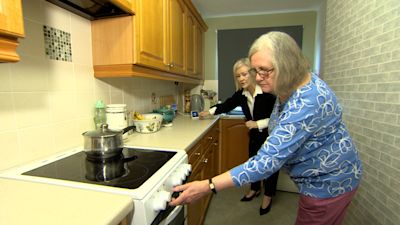Insight
How lives have been changed in the North West by energy's 'April Cruel Day'

Video report by ITV correspondent Rob Smith
When the home energy assessment team arrived at Lillian Griffiths' flat in New Brighton, they brought a monitoring device which reveals - in colour - just how much energy a household is using.
Seeing that, in such a stark manner, was a shock for the former counsellor given the biggest rise in energy bills in living memory which has been dubbed "April Cruel Day."
Once her usual kitchen appliances were switched on, the meter's display moved from green to amber and then to red.
Lillian was "unbelievably surprised" by the revelation. "I couldn't believe it," she says, "I have wondered [what it costs] when I make the tea, just for one person."
In future, she is going to change her cooking methods to save money, shunning the oven and hob for lower-energy alternatives she already owns - a microwave and slow cooker.
One of the home energy assessors, Linda Salt, told Lillian that each traditional light bulb swapped out for a low-watt LED alternative could save as much as £13 a year.
Installing reflective foil panels behind radiators, which can cost as little as £20 to reflect heat back into a home, can make a difference too.
"Energy prices are going up by 54 per cent," says Linda. "I have been in the energy sector for 35 years and I have never experienced anything like this."
For Leah Brocklehurst, the budget calculations have become tough. With soaring energy costs, the part-time care home worker is trying to make every penny go further.
We met her as she was trying to buy a much-needed secondhand sofa for her and her two daughters, because the family have little furniture to their name. But the £37 cost was a stretch because of their energy bill.
"In our place it is too cold without the heating", Leah told us. "For myself, I can take the cold but for my kids I need it on. It is very expensive."
To find more ways for people like Leah to save energy, researchers at the University of Salford are using a house - built inside a giant metal box which can mimic different weather conditions.
The Energy House project is filled with sensors to test boilers, insulation, electrical devices and a host of other items. The goal is to see what is the most efficient.
Closing curtains and blinds at night, turning down radiators in unused rooms or during quieter periods and lowering the thermostat itself are simple ways to help.
The team demonstrated for our cameras a 'hidden' second thermostat built into many boilers.
The setting lowers the temperature of the water flowing into a home's heating pipes and radiators. It can mean a house takes longer to warm-up but it can save gas and money too.
The project's Dr Richard Fitton points to installing loft insulation as one of the biggest possible wins as there are many homes which still do not have it or have enough of it.
"It's a DIY install or a simple builder's install," he says.
Teams of insulation retrofitters are installing energy-saving measures on the outer walls of houses across the North West, where a layer of insulation can be attached and then covered with a cement coating.
The savings are huge, especially if combined with more efficient boilers or modern heat pumps and solar panels.
The costs are huge too, potentially running to many thousands of pounds. Yet grants are available for low income households whose homes leak heat.
"It feels fantastic," says Next Energy's Richard Jones who works with councils across the Liverpool City Region. "The minute we add insulation... we bring carbon footprints down and lower bills."
Policing Minister Kit Malthouse admitted the energy bill situation would be "extremely tough for millions of people across the country," saying the Chancellor had "moved to assist." He cited the increase in the living wage and the national insurance threshold rise.